A Vegan Five-Course Dinner at Harvest Beat
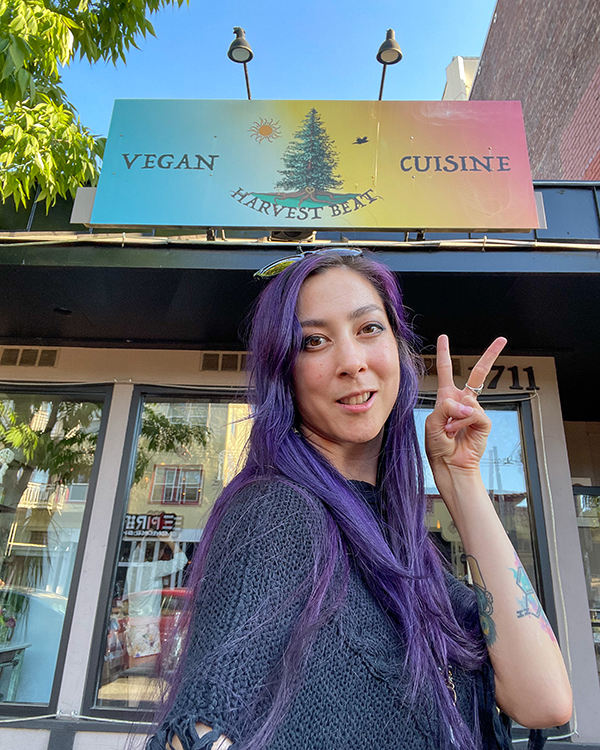
For years, I’ve heard reviews gushing over the best vegan five-course dinner only at Harvest Beat. As a vegan in Seattle, I’ve visited most of this city’s plant-based restaurants, the cuisine ranging from greasy spoon to organic salad bars. Harvest Beat has always been on my list of places, yet for years, it had eluded me. A voice in my head said, “Someday, someday, someday…” Yet I just needed to find the right time to try their five-course meal.
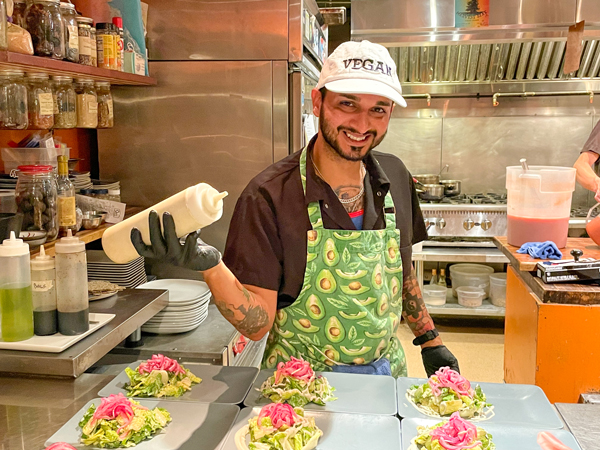
My friend Karim Gwaduri, a co-chef at Harvest Beat, offered to have me as a special guest at their table. You may remember Karim from the vegan cooking class he taught a couple years ago. Since writing the blog post about his cooking class, Karim has since advanced in his culinary career. He now helps concoct recipes at Harvest Beat. I’ve really enjoyed seeing my friend spread his wings and work his way up the Seattle vegan restaurant network.
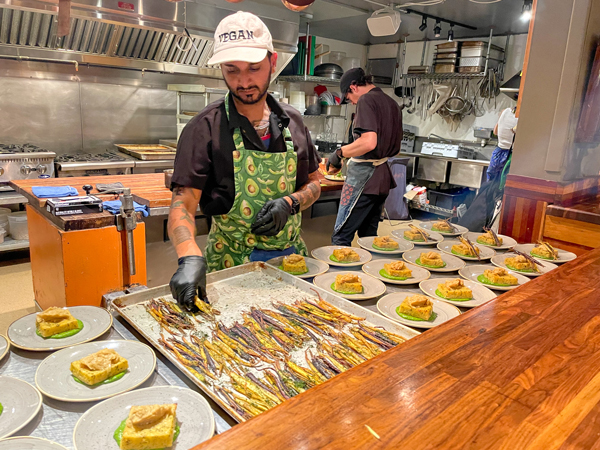
Reducing food waste in a vegan lifestyle
As a vegan, I try to be mindful about how much waste my lifestyle produces while reducing my carbon footprint. So, I would like to visit places that reflect those values as well. At Harvest Beat, their mission is to promote a healthier world by lightening their carbon footprint while stepping into their full creative freedom as chefs. As such, their menu changes every four weeks to reflect the available produce during the current season–so that chefs like Karim can create food that’s intuitive and inspired.
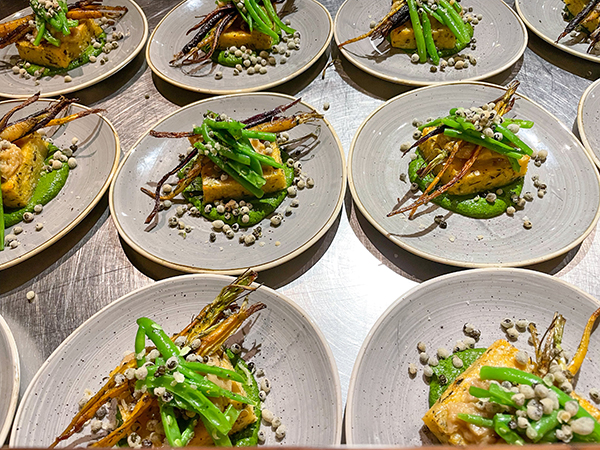
Another way Harvest Beat aims to reduce waste is by using as much as the produce as possible. That means that the parts of a vegetable that are usually thrown out are still edible, such as the white ends of green onion. The restaurant uses organic produce by partnering with local farms throughout the Pacific Northwest. Farmers and foragers scour the region, from Northern California to British Columbia. The PNW terrain has diverse climates, ranging from more arid desert to lush forests. So, more variety of fruits, vegetables, and nuts can be found during different times of the year in these climates. Some of Harvest Beat’s food is even grown on their very own rooftop garden!
All food scraps get composted, which eventually breaks down and recycles back into the earth. So, the food comes full circle (no pun intended) here!
The vegan five-course dinner at Harvest Beat
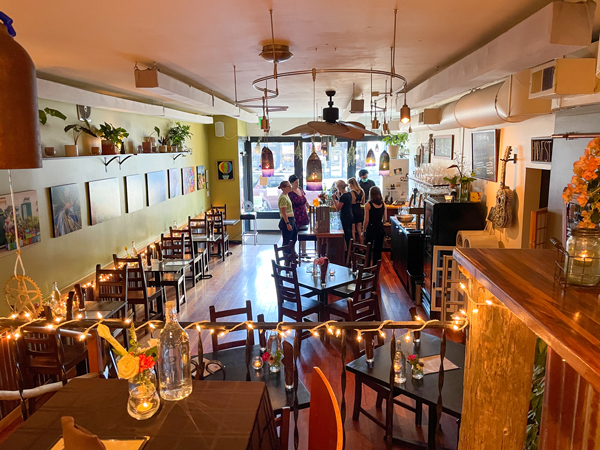
The ambience of Harvest Beat is intimate and welcoming. Warm, soft lights and tea candles illuminate the restaurant, as plants and art made from found objects give the space a cozy atmosphere. True to their reduced waste mission, the green and tan walls are made from eco-friendly paint, and the bar is made from recycled beach wood and bar top.
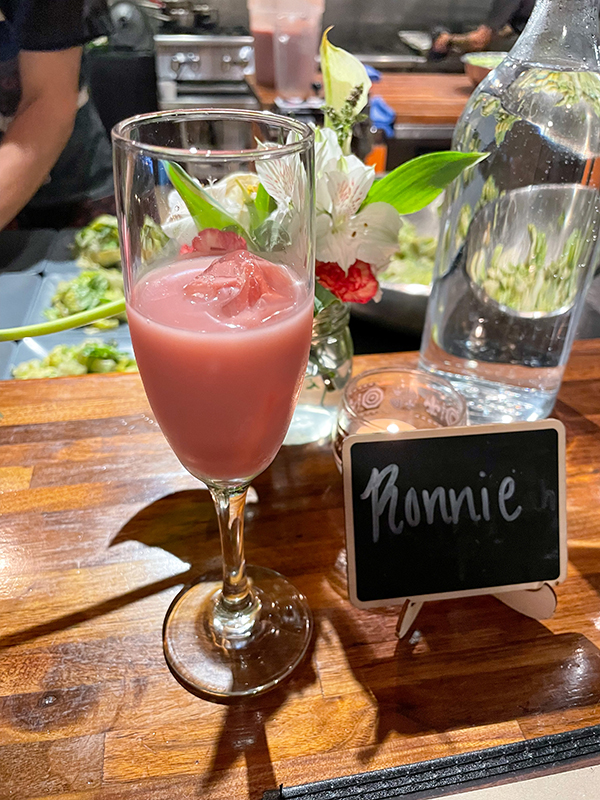
When I entered Harvest Beat, the server led me to a special seat with my name on it in front of the kitchen. I got to have a front row seat of watching Karim and his co-chef make the magic happen!
This menu does offer dishes with nuts. If you have any food or nut allergies, you can call the restaurant in advance and they’ll make accommodations for you.
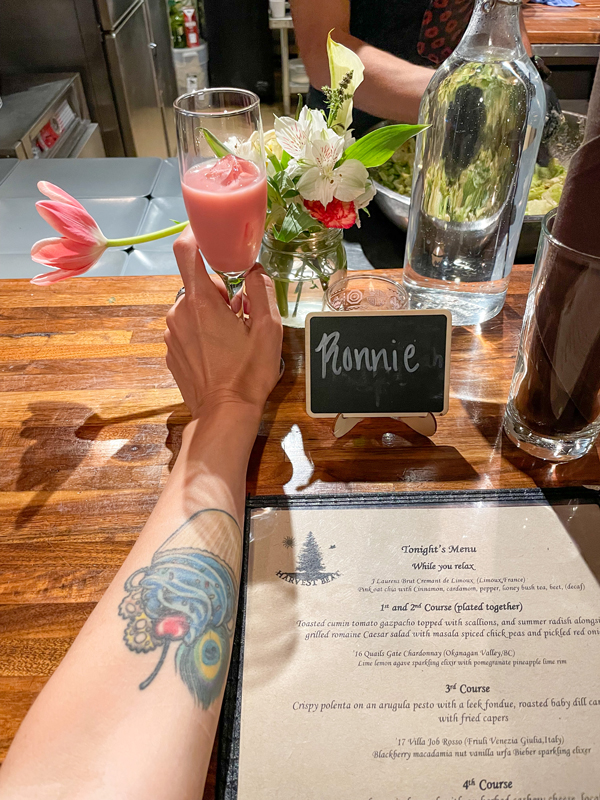
For this evening seating, I asked for the dinner with non-alcoholic pairing. If you prefer alcohol, there are wine pairings with each course. While I waited for dinner to begin, I enjoyed a glass of this pink oat chia honey bush tea that was spiced with cinnamon and cardamom, and tinted with beet juice. I thought it was refreshing to have, since it set the anticipation of the delicious experience to come.
Ten minutes after the last guest arrived, Karim rang the large bell to signal the start of the two-hour dinner. He thanked everyone for coming and introduced them to Harvest Beat’s mission. By knowing where their food comes from, people can appreciate what they have in front of them even more. It offers a fresh perspective that there’s a whole system that brings food from the farm to the table.
The first and second course (plated together)

At Harvest Beat, the first and second courses are always plated together. They’re usually a soup and salad combo. These courses start off light and progress towards the more filling main courses before finishing with dessert. Wrapped up in a napkin was a knife, two spoons, and three different forks for the five courses.
For this summer menu, the first course was toasted cumin tomato gazpacho topped with scallions, green chive oil, and summer radish. The flavorful gazpacho was a refreshing summer soup served cold. On the same plate was a grilled romaine Caesar salad with masala-spiced chick peas and pickled red onion. The zesty cashew-based Caesar dressing was salted with caper juice.
The drink pairing for these two courses was a lime-lemon elixir sweetened with agave, with a salty pomegranate pineapple rim. It was almost like drinking a non-alcoholic martini in a wine glass.
The third course

After warming our appetites up with the gazpacho and Caesar salad, it was time for the third course: Crispy polenta on an arugula pesto with a leek buttery fondue, roasted baby dill carrots, and finished with fried capers.
This third course tasted like a play on a variety of textures and flavors. The crispy outside contrasted with the creamy, softly gritty texture on the inside of the polenta. Likewise, it boasted a delicate balance of salty and sweet. The polenta rested on a pool of bright green arugula and basil pesto–the minty basil balances out the peppery arugula flavors. The leek fondue or butter on top of the polenta was cooked down to a low temperature until it became creamy. Roasting the green beans and carrots brought out their sweetness. Sprinkled on top, the fried capers added a salty, crispy texture.
The mocktail that accompanied it was a purple sparkling macadamia nut elixir made with blackberries, vanilla, and urfa bieber (a Turkish chili), and garnished with a blackberry and a sage leaf.
The fourth course
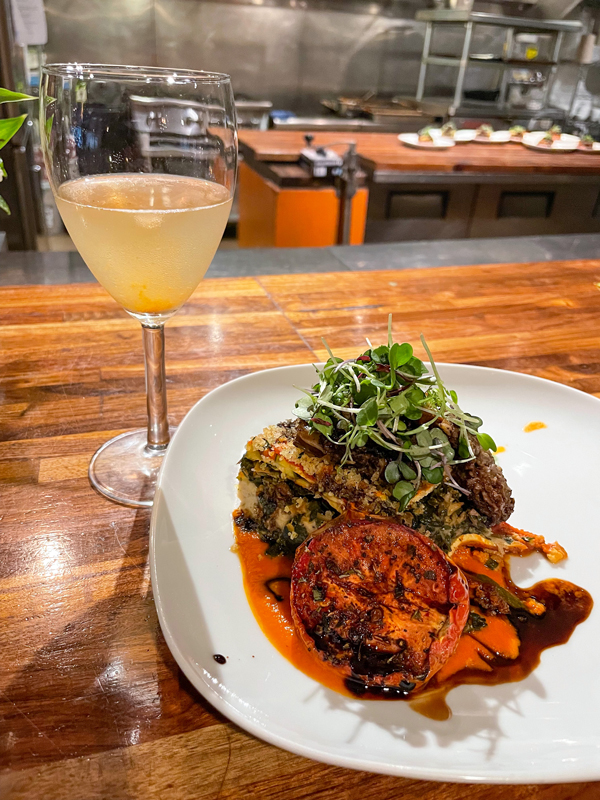
Then came the fourth course, or the main course of the menu. On an apple-smoked tomato sauce, the summer squash gratin was layered with generous herb cashew cheese at the bottom, zucchinis, and kale, and then topped off with breadcrumbs, roasted morel mushrooms, micro greens, and a balsamic reduction. Half of a roasted tomato completed this dish. As with the third course, roasting brings out the sweetness in the tomato. I remember Karim once saying how the balsamic vinegar, another acid, cuts the acidity of tomatoes.
This Italian-inspired fourth course was my favorite at Harvest Beat. Like the third course, the contrast between savory and sweetness paired well together. And because I have always had a soft spot in my heart for vegan cheese, it made it extra special. This cashew cheese was filling and flavorful. Dare I say that my head was buzzing from the dopamine receptors soaking it all in.
The drink pairing with the summer squash gratin was a sweet basil lemonade with hints of rose, apple, and carrot.
The fifth course
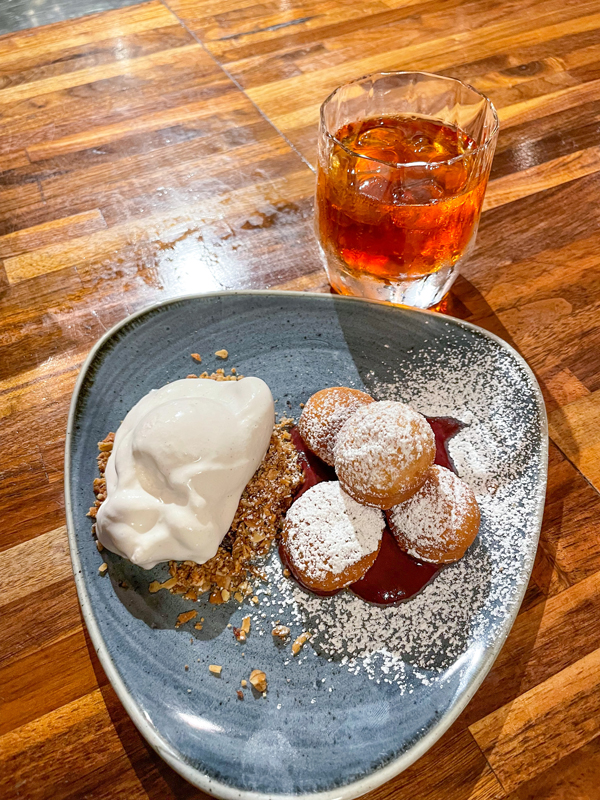
There was still one more course left at Harvest Beat, which was the fifth course, or dessert. There were four dainty bite-sized beignets, or fried pastry balls, on top of foraged Saskatoon elderberry coulis, a thin fruit puree used as a sauce. Powdered sugar is sprinkled on to give the beignets a little sweetness. Next to the beignets was a scoop of vanilla coconut ice cream on a bed of crushed granola. The ice cream was made with just three ingredients: coconut milk, vanilla bean, and sweetened with agave nectar.

For this course, I sopped up the pillow-y beignets with the elderberry coulis. The crunchy granola added even more textural contrast with the soft ice cream. I really appreciated how the dessert wasn’t overly sweet. It had just enough sweetness to satisfy me at the end of an elaborate meal.
The last drink was a chilled Harvest Beat tea blend. The mellow flavor was a good ending to this delectable meal.
Last thoughts on the vegan dinner at Harvest Beat
I was so honored to eat at this multi-course vegan dinner at Harvest Beat! I’m proud of Karim for living his truth in vegan fine dining. I’m glad to see how Harvest Beat does its part to lessen its environmental impact by sourcing food locally and reducing as much waste as possible. Sometimes we also need to remind ourselves how much work goes into getting quality food from the farm to the table. Because this is the kind of food that keeps us healthy and alive–while working to leave the planet a better place than we found it.
1 Comment
darenmd
Wonderful read, Ronnie!